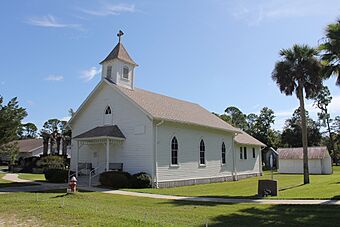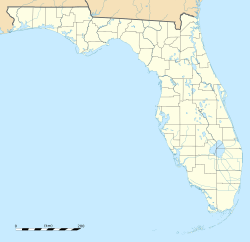St. Mary Catholic Church (Korona, Florida) facts for kids
Quick facts for kids |
|
|
St. Mary Catholic Church
|
|

St. Mary Catholic Church - Front Right Side View (Photo taken August 21, 2019)
|
|
| Location | 89 St. Mary’s Place, Bunnell, Florida |
|---|---|
| Area | 1,955 square feet (180 m2) |
| Built | 1914 |
| Architectural style | Carpenter Gothic (Gothic Revival) |
| NRHP reference No. | SG100009785 |
| Added to NRHP | January 25, 2024 |
The St. Mary Catholic Church is also known as the St. Mary Mother Church. It is located in Bunnell, Florida. This church was built with wood and has a special design called Carpenter Gothic. This style looks like older Gothic churches but uses wood instead of stone.
In the early 1910s, many families from Poland moved to a town called Korona, Florida. They wanted to build a Catholic church. They raised $1000 to make this happen. The name Korona means "crown" in Polish. This name honors the Blessed Virgin Mary, who is also called the "Queen of Poland."
The church building was finished in 1914. It was first named St. Mary, Queen of Poland, Catholic Church. Later, its name was changed to St. Mary Catholic Church. This original church building is still used today for many services. People go there for daily mass, baptisms, funerals, weddings, and quiet prayer.
From the very beginning, St. Mary Catholic Church has been a very important place for the Korona community. It is still a big part of the spiritual and cultural life for people in the area. The St. Mary Catholic Church is the oldest church building in Flagler County.
The church property also has the Shrine of Saint Christopher. There are four other buildings too: a Parish Thrift Store, a Storage Shed, a Parish Center Office, and the Main Church.
Contents
Church Design and Features
The St. Mary Catholic Church building is about 1955 square feet. It is 31 feet wide and 62 feet long. There is also a small garage part that sticks out from one corner.
Outside the Church
Most of the church's outside walls are made of white painted wood. The wood planks run sideways. There is also a wood lattice around the bottom. This covers the space under the floor.
The church has eight lancet windows. These windows are tall and narrow. They have a pointed arch at the top. This design copies the look of old Gothic churches. The glass in these windows is clear and wavy. The St. Mary Catholic Church has never had colorful stained glass in its outside windows.
Two sections were added to the back of the church in the 1930s. One part was a home for the priest. It had a living room, bedroom, bathroom, kitchen, and a safe room. The other part was a garage for the priest's car.
The front of the church faces west. It has a concrete porch that replaced the original wood one. This porch is 12 feet wide and 5 feet long. It has four steps and metal hand railings. Two wooden entrance doors with rounded tops open outwards into the church. The porch has two wooden benches. It also has a wooden roof with asphalt shingles, just like the main church roof. Wooden pillars hold up this porch roof. A sign by the entrance doors says, "St. Mary’s Church – Built by a Group of Polish Immigrants in 1914."
Above the porch roof, there is one lancet window in the center. The bottom part of this window has two white painted sections. The top part has three lancet-shaped panes with clear, wavy glass.
The right side of the church (south side) has three lancet windows in the original part. Each of these windows has clear, wavy glass. The back section added later on this side has three double-hung windows with clear, flat glass.
The left side of the church (north side) has four lancet windows in the original part. These windows also have clear, wavy glass. The garage section added to the back on this side has two wooden garage doors that swing open.
The back of the church (east side) has a single wooden entrance door. It has a five-step concrete porch and a wooden handrail. There are three double-hung windows here, but they are now covered with wood. The garage section also has three vertical windows that are covered. A wooden roof covers these windows and the back door. It has asphalt shingles like the main roof. Above this roof, there is a hinged wooden door that leads to the attic. A single air vent is near the top of the roof in the original part of the building.
The church's wooden roof, both on the original and added parts, is covered with matching asphalt shingles. Modern aluminum pipes carry rainwater away from the roof. The steeple is at the front of the church. It has four wooden openings with louvered air vents that look like arrows. The steeple's roof also has asphalt shingles. A Christian cross made of wood and covered with copper is at the very top of the steeple. A bell is inside the steeple and can be rung by hand.
Exterior Picture Gallery
Inside the Church
Inside the church, there are fourteen pews, which are long benches for people to sit on. Seven pews are on each side of the middle aisle. The walls in the main church area and the original sacristy room have a special wood trim called chair molding. This molding is about three and a half feet from the floor.
Below the chair molding, the walls have vertical wooden panels called bead board wainscoting. Above the chair molding, the same bead board wainscoting runs horizontally to the ceiling. The entire ceiling is also covered with this same wooden paneling. All the chair molding and wooden paneling are painted white.
Near the front entrance, there is a confessional room. It has separate doors for the priest and for the person confessing. There are also double entrance doors with rounded tops. A stairway leads up to the choir chamber. Another door under the stairs leads to a storage room. The choir chamber is an upper area at the front with seating and a four-foot-high railing.
The pulpit area includes wooden railings, a baptismal font, and the main altar. There is also a smaller altar with a statue called the Statue of the Redeemer in Death. This statue is used during Easter services. Many other statues, pictures, and church items are also found here. A single door leads into the church's original sacristy room.
The section that used to be the priest's living quarters is now used for storing furniture and church items. The section that was once the priest's garage is now used for storing various maintenance supplies.
Interior Picture Gallery
Shrine of Saint Christopher
The Shrine of Saint Christopher was built in 1935. Saint Christopher is known as the patron saint of travelers. A missionary named Rev. Fr. Cornelius Hoffman, who studied in Poland, built it. The shrine is located on the church property, to the left (north) side of the St. Mary Catholic Church.
The shrine's base is 28 feet by 40 feet, and it stands 24 feet high. This shrine was a gift to the Korona community. It is a place where drivers can stop, visit, and pray to the Patron Saint of Travelers. Since the 1960s, St. Mary Catholic Church has held special services called the Blessing of Automobiles. During these events, drivers are invited to have their cars blessed in front of the Shrine of Saint Christopher.
The shrine has an altar on its west side. It has a message carved into it. The message asks for God's blessing on visitors as they travel. It wishes them peace, health, and joy on their journey.
Shrine of Saint Christopher Picture Gallery
History of Korona, Florida
Rev. Michael Curley, who was a bishop, bought land for just $1.00 in the center of Korona. This is where the Catholic church building would be built. The church was first named St. Mary, Queen of Poland, Catholic Church. Later, its name was changed to St. Mary Catholic Church. This church quickly became the heart of the community. It is still a very important symbol for the people of Korona.
When the Polish families arrived in Korona, they started building homes and farms. They also built their church. Since 1955, Korona has been part of the Bunnell post office service area.
The area was wild and challenging. It had thick forests, heavy soil, many insects, and poor drainage. There were not many good roads, only the railroad. This made it hard for farmers to grow crops and transport them to sell.
By 1922, car travel got better when the Dixie Highway reached Korona. By the 1930s, U.S. Highway 1 also ran through Korona. These roads made it much easier to travel to and from Korona by car. They also connected the town to more places that the railroads did not reach.
In 1926, Barney Trojanowski built the White Eagle Hotel. The first floor of the hotel was a grocery store, a feed store, and a real estate office. The second floor had rooms for the family and guests. The building was a social place for many years. It had a beer garden after 1934 and a large dance floor. Many festivals and special events, including those sponsored by St. Mary Catholic Church, were held there. In 1959, the White Eagle Hotel building was taken down. This made space for U.S. Highway 1 to be made wider.
In 1935, the Shrine of St. Christopher was built by Rev. Fr. Cornelius Hoffman. It was a gift to Korona. Many community and church events have happened at this shrine. The popular Blessing of the Automobiles is one of them. Since it was built, this shrine has brought many travelers to Korona. It is still a popular stop for drivers.
In 1940, life in Korona greatly improved when electricity came to the area. Suddenly, this rural community had a way to improve its living standards. This helped the community develop in modern ways.
As the Korona community grew during the 20th century, the original St. Mary Catholic Church became too small. A new, larger St. Mary Catholic Church was built. It was officially opened on October 8, 1994. This bigger church can hold up to 500 people. It even welcomes Polish-speaking church members who travel from far away.
In 2011, a new Parish Center was built on the St. Mary Catholic Church property. It has classrooms, offices, and a social hall. In 2014, the St. Vincent DePaul Thrift store was also built on the church property. This store provides affordable clothes and household items to people in need in Korona and nearby towns.
Becoming a Historic Place
The St. Mary Catholic Church was nominated to become a historic place. The Florida National Register Review Board approved this on November 2, 2023. Then, it was sent to the U.S. Department of the Interior, National Park Service for final approval. On January 25, 2024, the St. Mary Catholic Church was officially added to the National Register of Historic Places.
This means the property is important for its architecture, its connection to Polish heritage, and its role in the area's settlement. The listing for St. Mary Catholic Church also included the Shrine of Saint Christopher as an important part of the historic property.















